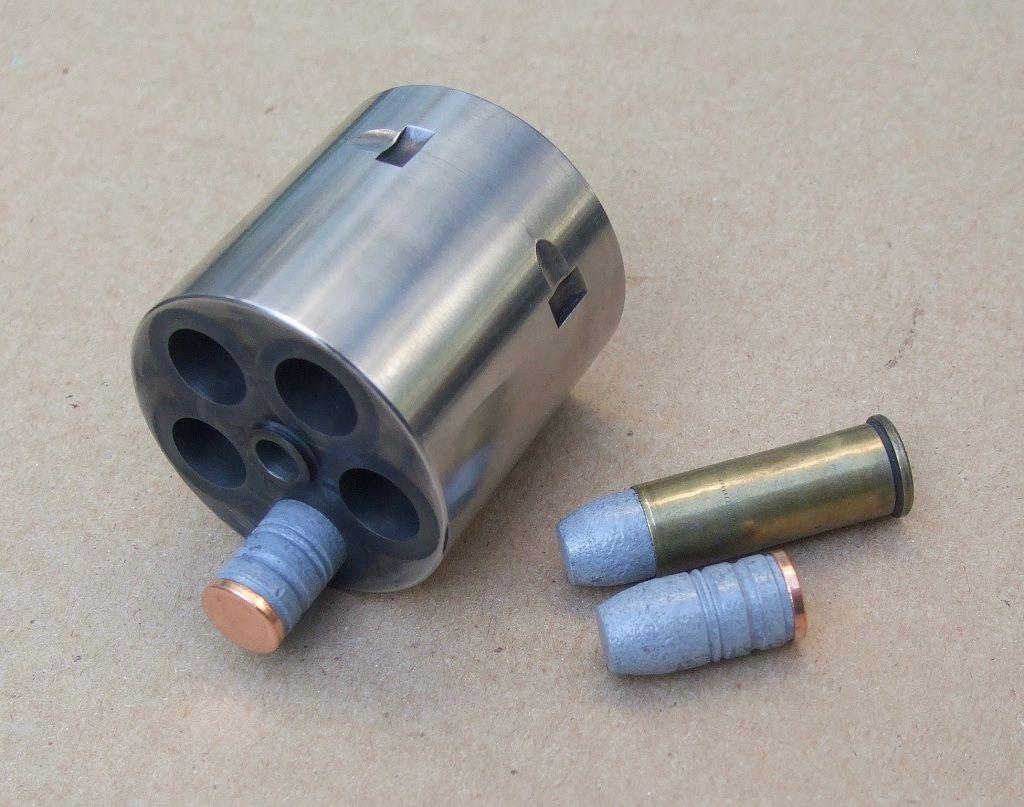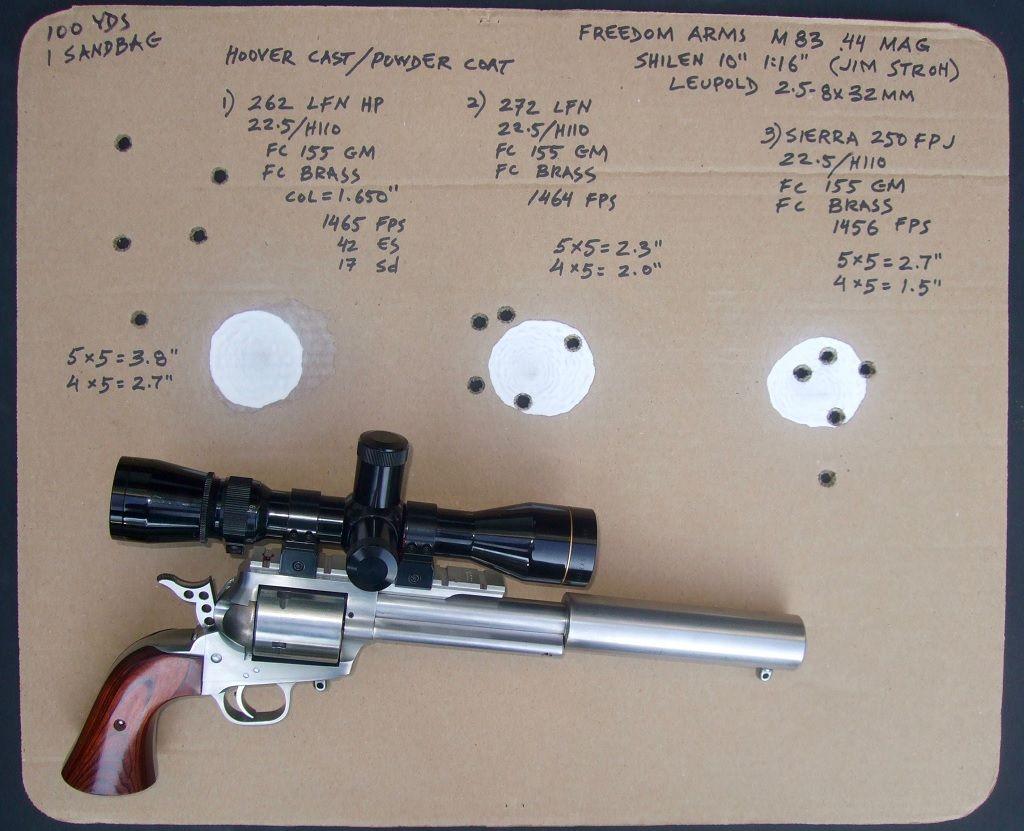Lee Martin
Hunter
Freedom Arms M83 .44 Mag cylinder. 327 grain LFN (Long Flat Nose) Gas Check, casting and Powder Coat by Tank Hoover. Bullets do not thumb-press through chamber exit holes. DEEP SEAT and roll crimp on beginning of ogive. Bullet contacts chamber throat (exit hole) as round is fully chambered. Tighter bullet sizing die would ease chambering, permit roll crimp in crimp groove. Charge of 19/H110 just about meets bullet base, easily room for one more grain. Firing rounds produced no evidence of leading of chamber leade or throat, nor in barrel forcing cone or bore.

Tank Hoover's bullet making process: 1) cast. 2) powder coat. 3) size, or apply gas check & size.
This Freedom Arms .44 cylinder has .429" exit holes. These 327 grain LFN GC bullets cast by Tank Hoover were sized .430-inch. Bullets do not thumb-press through chamber throats. Only the target can tell whether it harms accuracy to pinch a bullet in the exit hole. That no leading was found in chamber leade, throat, forcing cone, or bore after shooting Hoover's PC bullets——262 LFN HP, 272 LFN, 327 LFN GC——suggests the powder coat process may introduce forgiveness to a cast bullet which grease on lead alloy does not.

The FORCING CONE is a necessary evil, analogous to the LEADE in a rifle barrel. Both must provide a smooth transition between the chamber exit and the LANDS of the rifling. As the revolver chamber is separate from the barrel, the forcing cone must accommodate minor chamber-to-bore offset. Too much forcing cone, or an off-axis forcing cone invites OBTURATION, or distortion of the bullet. A proper forcing cone cannot cure a bad barrel, nor make up for gross chamber-to-bore offset. By any measure this is a minimal forcing cone.

Cast .44 Powder Coat 327 grain LFN GC snugs forcing cone of Shilen barrel in Freedom Arms M83. Jim Stroh cut very short 11-degree cone on lathe. Bullet acts as alignment pin between chamber and bore——providing chamber throats and forcing cone are not grossly oversize. The 11-degree forcing cone is an industry standard, not a custom gunsmith invention.

Three Tank Hoover P0WDER COAT bullets were tried in the Freedom Arms .44 with Shilen barrel. Powder charge same as moderate charge of 22.5/H110 under Sierra's excellent 250 FPJ and 210 JHC. One prior shot was fired at a separate target to check ZERO----the 262-grain LFN HP over 22.5/H110 printed 8" high @ 50 yards. To put POI (Point of Impact) close to center, the Leopold DOT reticle implanted edge of cardboard @ 6 o'clock (sketched in blue).
262 LFN HP is hollow point version of 272 LFN. While 262 LFN HP may appear more accurate on this target, human factor intervened on groups fired with 272 LFN and 327 LFN GC. Revolver fired from trunnion position on single sandbag.

Sketched in blue, Leupold Dot-on-crosshair reticle records very high impact of PC bullets @ 50 yards with scope sighted for Sierra 250 FPJ jacketed rounds. Same 22.5/H110 powder charge

REDDING COMPETITION SEATER remains Bradshaw's favored die for effortless, straight-line seating with disparate nose profiles. Each hashmark represents .001-inch change in depth; "20" equals .020", etc. In conjunction with seating, a Redding expander with built-in step helps start bullet square, with a minimum of flare at the mouth for long case life. Target 50 yards.

3 groups @ 100 yards
1) Cast LBT 262 LFN HP, powder coat.
Promise of accuracy @ 50 yards give way to dispersion @ 100 yards. As first 4-shots group 2.7-inches, with 5th shot dropping to open 5x5 to 3.8-inches, actual dispersion cannot be concluded.
2) Cast LBT 272 LFN, powder coat.
Consistency very likely to repeat, as 5x5=2.3-inches @ 100 yards, with 4X5 into 2.0-inches. Suspect that with the anneal from 400-degrees fahrenheit during powder coat, this bullet should prove excellent on soft skin game up to 400 pounds and, in some instances, greater weight.
3) Sierra .4295 250-grain FPJ silhouette bullet.
Fired as a control, first 4-shots print 1.5-inches. Shot #5 is called "6 o'clock," and, alas, opens group to 2.7-inches. The five Sierras fired post-sunset. (Velocity of "1456 fps" is incorrect. Five shots of Sierra 250 FPJ over 22.3/H110 average 1,426 fps.)
Preliminary finding
These powder coat bullets shoot. The cast 262 LFN HP and 272 LFN over 22.5/H110 could be and were interchanged with jacketed Sierra bullets without the firing of fouling shots to settle ZERO. However, Point of Impact (POI) of the cast powder coat bullets averages 8" higher @ 50 yards, and 14" higher @ 100 yards, than the Sierra 250 FPJ with the same powder & charge.


Tank Hoover's bullet making process: 1) cast. 2) powder coat. 3) size, or apply gas check & size.
This Freedom Arms .44 cylinder has .429" exit holes. These 327 grain LFN GC bullets cast by Tank Hoover were sized .430-inch. Bullets do not thumb-press through chamber throats. Only the target can tell whether it harms accuracy to pinch a bullet in the exit hole. That no leading was found in chamber leade, throat, forcing cone, or bore after shooting Hoover's PC bullets——262 LFN HP, 272 LFN, 327 LFN GC——suggests the powder coat process may introduce forgiveness to a cast bullet which grease on lead alloy does not.

The FORCING CONE is a necessary evil, analogous to the LEADE in a rifle barrel. Both must provide a smooth transition between the chamber exit and the LANDS of the rifling. As the revolver chamber is separate from the barrel, the forcing cone must accommodate minor chamber-to-bore offset. Too much forcing cone, or an off-axis forcing cone invites OBTURATION, or distortion of the bullet. A proper forcing cone cannot cure a bad barrel, nor make up for gross chamber-to-bore offset. By any measure this is a minimal forcing cone.

Cast .44 Powder Coat 327 grain LFN GC snugs forcing cone of Shilen barrel in Freedom Arms M83. Jim Stroh cut very short 11-degree cone on lathe. Bullet acts as alignment pin between chamber and bore——providing chamber throats and forcing cone are not grossly oversize. The 11-degree forcing cone is an industry standard, not a custom gunsmith invention.

Three Tank Hoover P0WDER COAT bullets were tried in the Freedom Arms .44 with Shilen barrel. Powder charge same as moderate charge of 22.5/H110 under Sierra's excellent 250 FPJ and 210 JHC. One prior shot was fired at a separate target to check ZERO----the 262-grain LFN HP over 22.5/H110 printed 8" high @ 50 yards. To put POI (Point of Impact) close to center, the Leopold DOT reticle implanted edge of cardboard @ 6 o'clock (sketched in blue).
262 LFN HP is hollow point version of 272 LFN. While 262 LFN HP may appear more accurate on this target, human factor intervened on groups fired with 272 LFN and 327 LFN GC. Revolver fired from trunnion position on single sandbag.

Sketched in blue, Leupold Dot-on-crosshair reticle records very high impact of PC bullets @ 50 yards with scope sighted for Sierra 250 FPJ jacketed rounds. Same 22.5/H110 powder charge

REDDING COMPETITION SEATER remains Bradshaw's favored die for effortless, straight-line seating with disparate nose profiles. Each hashmark represents .001-inch change in depth; "20" equals .020", etc. In conjunction with seating, a Redding expander with built-in step helps start bullet square, with a minimum of flare at the mouth for long case life. Target 50 yards.

3 groups @ 100 yards
1) Cast LBT 262 LFN HP, powder coat.
Promise of accuracy @ 50 yards give way to dispersion @ 100 yards. As first 4-shots group 2.7-inches, with 5th shot dropping to open 5x5 to 3.8-inches, actual dispersion cannot be concluded.
2) Cast LBT 272 LFN, powder coat.
Consistency very likely to repeat, as 5x5=2.3-inches @ 100 yards, with 4X5 into 2.0-inches. Suspect that with the anneal from 400-degrees fahrenheit during powder coat, this bullet should prove excellent on soft skin game up to 400 pounds and, in some instances, greater weight.
3) Sierra .4295 250-grain FPJ silhouette bullet.
Fired as a control, first 4-shots print 1.5-inches. Shot #5 is called "6 o'clock," and, alas, opens group to 2.7-inches. The five Sierras fired post-sunset. (Velocity of "1456 fps" is incorrect. Five shots of Sierra 250 FPJ over 22.3/H110 average 1,426 fps.)
Preliminary finding
These powder coat bullets shoot. The cast 262 LFN HP and 272 LFN over 22.5/H110 could be and were interchanged with jacketed Sierra bullets without the firing of fouling shots to settle ZERO. However, Point of Impact (POI) of the cast powder coat bullets averages 8" higher @ 50 yards, and 14" higher @ 100 yards, than the Sierra 250 FPJ with the same powder & charge.

